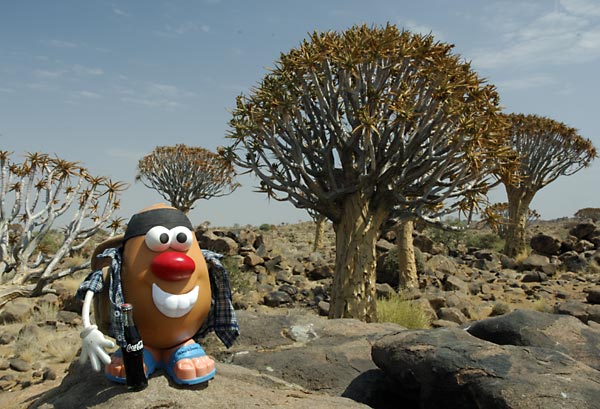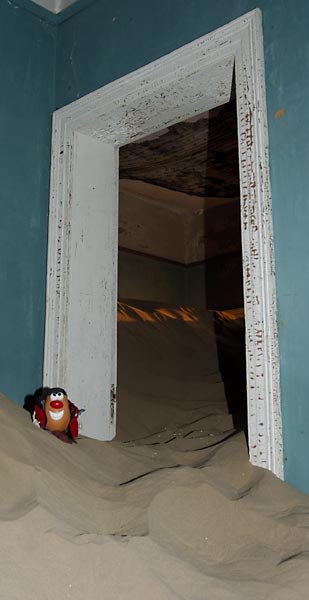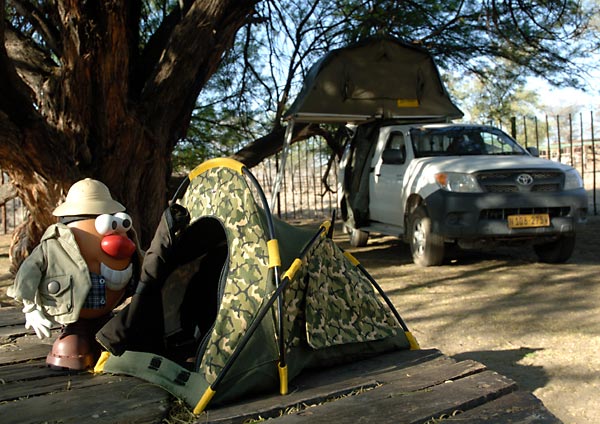

In September of 2007, Spud journeyed to the Kalahari desert of the southwest African nation of Namibia in search of N!xau, the San bushman noted for his fame in 'The Gods Must be Crazy'.
In the movie he was hit in the head with an empty coke bottle that fell from the 'heavens' (actually it was tossed out of a cessna by a callous bush pilot that was flying overhead). Spud thought it rather insensitive that N!xau never did receive the tasty beverage, so he planned on giving him a bottle straight from the factory which he had picked up in Atlanta, on a previous trip.
Surviving in the sweltering heat of the Kalahari is something the San people have adapted well to. In preparation for long hot summers and times of drought, the San would steal Ostrich eggs. Drill a small hole in one end. Pour out the yolk and egg white, then refill the egg with water. A wood stopper plug would be inserted in the hole and then the bushmen would bury the egg, thereby storing the precious water for the future.
Spud searched for where there were Kokerboom trees as it is the San people who use the lightweight branches from the tree as quivers for carrying their poisonous arrows used in hunting.
 The
tato's intuition was correct, as he did come across a San bushman near
a Kokerboom Forest deep in the Kalahari. Spud told the man of his quest
to find N!xau to give him the full bottle of Coke, but the bushman replied
that a King had arrived from the heavens with a massive supply of the
black nectar. Spud was sure that the bushman didn't understand him, and
insisted he be taken to his village.
The
tato's intuition was correct, as he did come across a San bushman near
a Kokerboom Forest deep in the Kalahari. Spud told the man of his quest
to find N!xau to give him the full bottle of Coke, but the bushman replied
that a King had arrived from the heavens with a massive supply of the
black nectar. Spud was sure that the bushman didn't understand him, and
insisted he be taken to his village.
After tracking through the dry underbrush for miles, the two finally arrived at the San village. The bushman rushed into a hut and emerged with their 'King'. Turns out their monarch was Bill Cosby, who had been banished here along with truckloads of the horrid 'New Coke' from the Company's marketing disaster back in the 80's. Not only did he have his stockpile of Cola, he also had a seemingly endless supply of Jello pudding pops.
Having failed in his quest, Spud consulted his guide book to see what else Namibia had to offer. The guide revealed that Namibia is also home to one of the oldest and driest deserts on the planet: the Namib. The vast desert also has a sea of sand, whose dunes rise over 300 metres (1000 feet) in height. Believing the guide to be a typo, as surely the dunes can't be that high, Spud set off for the heart of the dune sea: the Sossusvlei.
The tater planned to stay in one of the many luxury lodges based around the Sossusvlei, but all were fully booked up by some 'celebrity' and his entourage. Turned out it was the gnome again. He and his cronies were in Namibia trying to squeeze the local lodges to provide rock bottom rates on their rooms. Travelocity would still sell those bookings to the general public at top dollar, and the gnome and his henchmen would pocket the rest.
Spud contacted the government's Namibian Wildlife resorts to see if they could find him alternate accommodation. After discussing his plight, the closest they could get for him was at the southern edge of the desert in the tiny hamlet of Kolmanskop. It was a long distance away, but the tater made his reservation and began the journey South.
 The
tato would find out hours later, that the rooms in Kolmanskop were not
vacant after all as the encroaching barchand sand dunes of the Namib had
moved in and were taking over the town. As it turns out, Spud would learn
that Kolmanskop is actually a deserted mining town that once was the center
of Namibia's rich diamond trade.
The
tato would find out hours later, that the rooms in Kolmanskop were not
vacant after all as the encroaching barchand sand dunes of the Namib had
moved in and were taking over the town. As it turns out, Spud would learn
that Kolmanskop is actually a deserted mining town that once was the center
of Namibia's rich diamond trade.
The town actually sprung up in 1908 when a railway worker found a diamond buried in the sand. As it turned out, the dunes in the area were choked with the precious gems and virtually overnight a rush of fortune seekers descended on the area - led by the South African diamond giant De-Beers. The village was built like a German town, with facilities like a hospital, ballroom, power station, school, skittle-alley, theater and sport-hall, casino, ice factory and the first x-ray-station in southern Africa. It also had a railway line to the nearby coastal town of Lüderitz.
Eventually
though, the majority of the diamond fines were exhausted and exploration
moved further south to an even richer locale near the town of Oranjemund.
Kolmanskop fell into decline and finally was abandoned in 1956. Since
then, Mother Nature has been reclaiming the town as the advancing dunes
of the Namib are swallowing the buildings.
Spud wound up having to pitch his tent even further away from the dunes near the South African border.